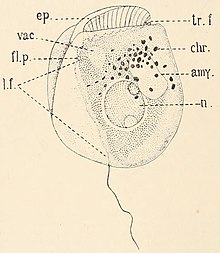Amphidinium
| Amphidinium | |
|---|---|

| |
| Lateral view of Amphidinium sulcatum. amy., amyloid body; chr., chromatophore; ep., anterior part of cell in front of transverse furrow; fl.p., flagellar pore; l.f., longitudinal furrow; n., cell nucleus; tr.f., transverse furrow (with flagellum); vac., vacuole. | |
| Scientific classification | |
| Domain: | Eukaryota |
| Clade: | Diaphoretickes |
| Clade: | SAR |
| Clade: | Alveolata |
| Phylum: | Myzozoa |
| Superclass: | Dinoflagellata |
| Class: | Dinophyceae |
| Order: | Gymnodiniales |
| Family: | Gymnodiniaceae |
| Genus: | Amphidinium Clap. & J.Lachm. 1859 |
Amphidinium is a genus of dinoflagellates. The type for the genus is Amphidinium operculatum Claparède & Lachmann. The genus includes the species Amphidinium carterae which is used as a model organism.[1]
As dinoflagellates, Amphidinium spp. have
plasmids. Most minicircles have only a few protein-coding genes; many have just a single gene.[2][3] There are reports of minicircles that do not have known transcripts, like in the Amphidinium carterae chloroplast genome,[3] although these were not found in the Symbiodinium sp. Clade C3 chloroplast genome.[2] Minicircle-derived transcripts can be processed in ways not typical of eukaryotes, including the addition of a 3' poly(U) tail,[3] as opposed to the typical poly(A) tail derived from polyadenylation of eukaryotic transcripts. Minicircle-derived antisense transcripts are also produced, but without 3' poly(U) tails.[3]
See also
- Luteophanol, a type of amphidinol present in species of the genus.[4]
References
Further reading
- Pagliaraa, Patrizia; Caroppo, Carmela (November 2012). "Toxicity assessment of Amphidinium carterae, Coolia cfr. monotis and Ostreopsis cfr. ovata (Dinophyta) isolated from the northern Ionian Sea (Mediterranean Sea)". Toxicon. 60 (6): 1203–14. PMID 22925842.
- Murray, Shauna A.; Garby, Tamsyn; Hoppenrath, Mona; Neilan, Brett A. (4 June 2012). "Genetic Diversity, Morphological Uniformity and Polyketide Production in Dinoflagellates (Amphidinium, Dinoflagellata)". PLOS ONE. 7 (6): e38253. PMID 22675531.

